FIN921: Managerial Finance Literature Review on Franking Credit Value
VerifiedAdded on 2022/10/02
|9
|2449
|466
Report
AI Summary
This report is a literature review on the market value of franking credits in the Australian financial system. It begins by outlining the introduction of the imputation tax scheme in 1987 and its impact on dividend taxation. The review explores the lack of consensus regarding the appropriate estimation of franking credits, which are crucial in determining the weighted average capital cost. The report then delves into a comprehensive literature review, discussing various studies and methodologies employed to assess the market value of dividends and franking credits. It examines diverse perspectives, from studies suggesting that imputation credits have no value to those estimating the credit's value based on dividend actions. The review explores the implications of dividend imputation on tax aggressiveness, the impact of foreign ownership levels on franking credit values, and different approaches used by scholars to determine market worth, including discounted cash flow models and regression analysis. The report also explores the use of aggregation approaches, regulatory perspectives, and short-trade contracts in valuing imputation credits. The conclusion synthesizes the findings, noting that the practical implication is that the imputation credit market value lies in the scope of 0.01 to 0.15 and that the value appears to have transferred with time in a direction that is steady with fluctuating tax treatment.
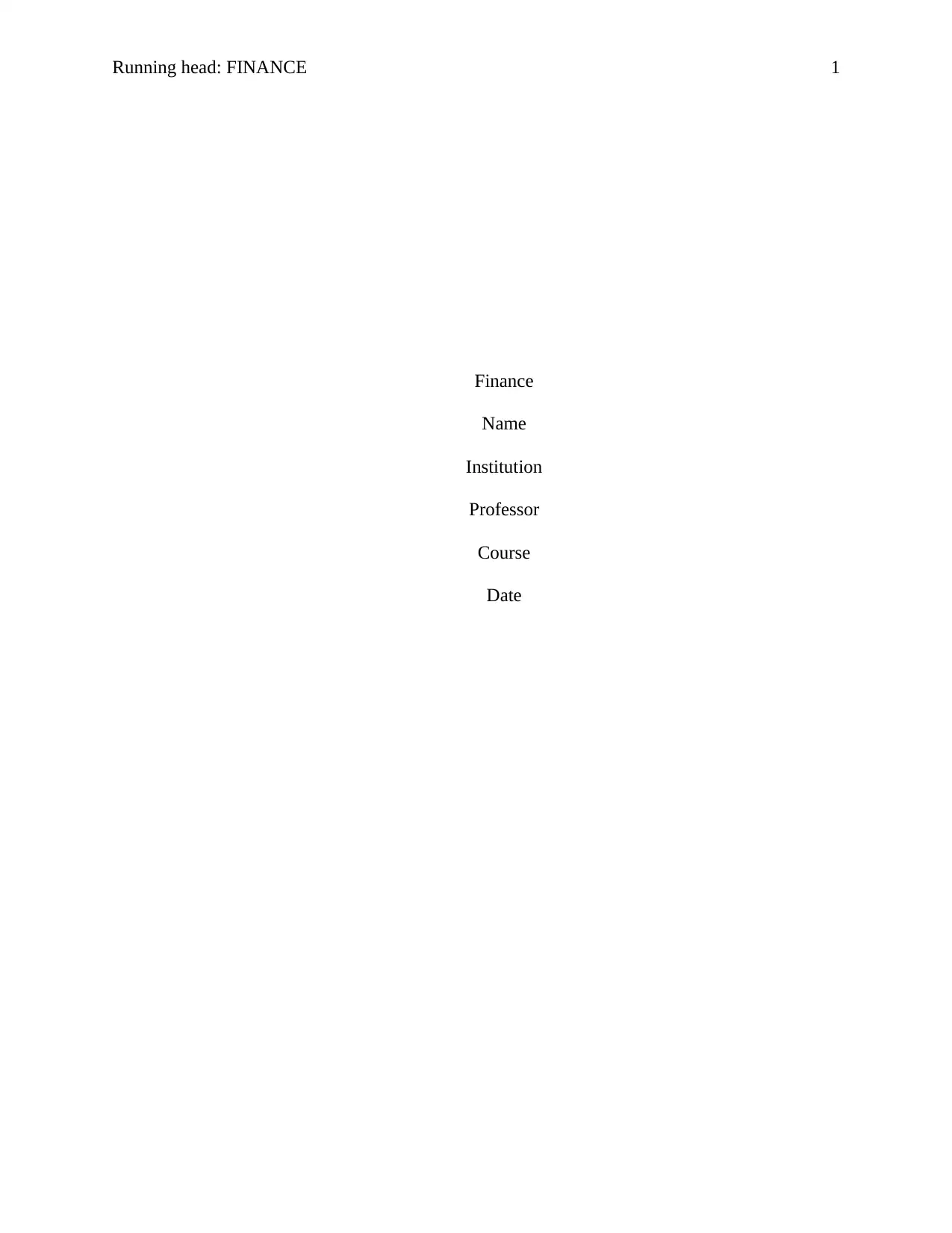
Running head: FINANCE 1
Finance
Name
Institution
Professor
Course
Date
Finance
Name
Institution
Professor
Course
Date
Paraphrase This Document
Need a fresh take? Get an instant paraphrase of this document with our AI Paraphraser
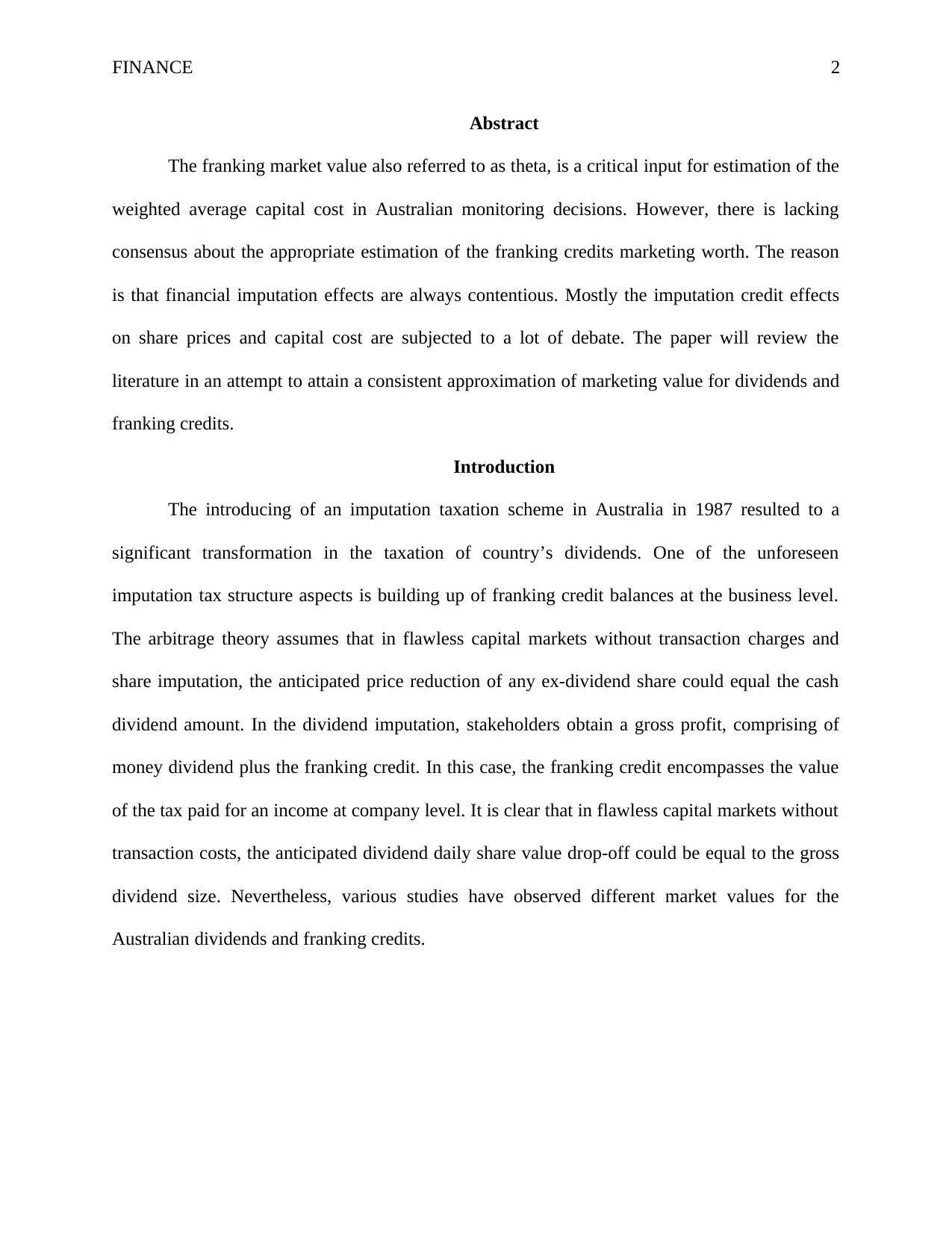
FINANCE 2
Abstract
The franking market value also referred to as theta, is a critical input for estimation of the
weighted average capital cost in Australian monitoring decisions. However, there is lacking
consensus about the appropriate estimation of the franking credits marketing worth. The reason
is that financial imputation effects are always contentious. Mostly the imputation credit effects
on share prices and capital cost are subjected to a lot of debate. The paper will review the
literature in an attempt to attain a consistent approximation of marketing value for dividends and
franking credits.
Introduction
The introducing of an imputation taxation scheme in Australia in 1987 resulted to a
significant transformation in the taxation of country’s dividends. One of the unforeseen
imputation tax structure aspects is building up of franking credit balances at the business level.
The arbitrage theory assumes that in flawless capital markets without transaction charges and
share imputation, the anticipated price reduction of any ex-dividend share could equal the cash
dividend amount. In the dividend imputation, stakeholders obtain a gross profit, comprising of
money dividend plus the franking credit. In this case, the franking credit encompasses the value
of the tax paid for an income at company level. It is clear that in flawless capital markets without
transaction costs, the anticipated dividend daily share value drop-off could be equal to the gross
dividend size. Nevertheless, various studies have observed different market values for the
Australian dividends and franking credits.
Abstract
The franking market value also referred to as theta, is a critical input for estimation of the
weighted average capital cost in Australian monitoring decisions. However, there is lacking
consensus about the appropriate estimation of the franking credits marketing worth. The reason
is that financial imputation effects are always contentious. Mostly the imputation credit effects
on share prices and capital cost are subjected to a lot of debate. The paper will review the
literature in an attempt to attain a consistent approximation of marketing value for dividends and
franking credits.
Introduction
The introducing of an imputation taxation scheme in Australia in 1987 resulted to a
significant transformation in the taxation of country’s dividends. One of the unforeseen
imputation tax structure aspects is building up of franking credit balances at the business level.
The arbitrage theory assumes that in flawless capital markets without transaction charges and
share imputation, the anticipated price reduction of any ex-dividend share could equal the cash
dividend amount. In the dividend imputation, stakeholders obtain a gross profit, comprising of
money dividend plus the franking credit. In this case, the franking credit encompasses the value
of the tax paid for an income at company level. It is clear that in flawless capital markets without
transaction costs, the anticipated dividend daily share value drop-off could be equal to the gross
dividend size. Nevertheless, various studies have observed different market values for the
Australian dividends and franking credits.
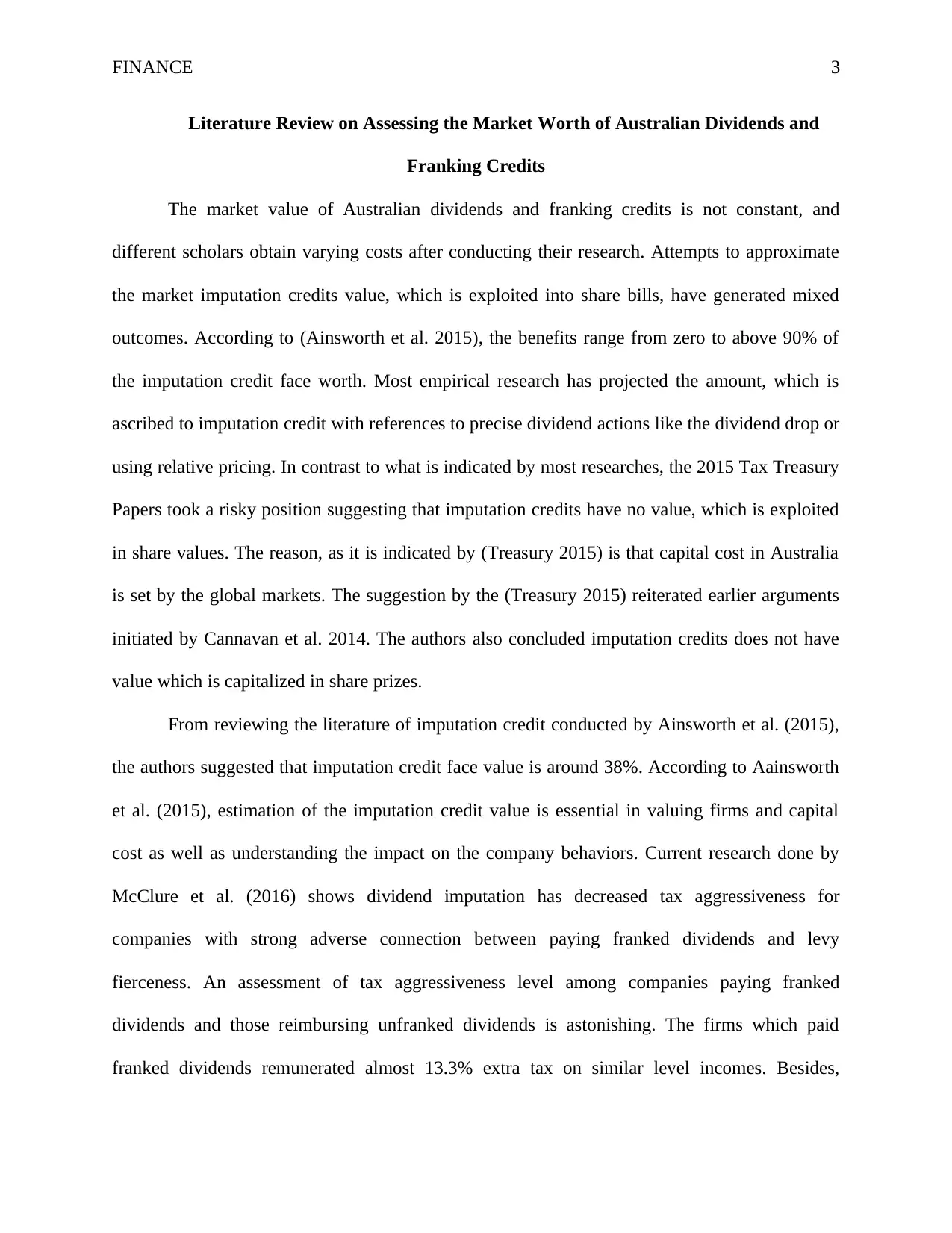
FINANCE 3
Literature Review on Assessing the Market Worth of Australian Dividends and
Franking Credits
The market value of Australian dividends and franking credits is not constant, and
different scholars obtain varying costs after conducting their research. Attempts to approximate
the market imputation credits value, which is exploited into share bills, have generated mixed
outcomes. According to (Ainsworth et al. 2015), the benefits range from zero to above 90% of
the imputation credit face worth. Most empirical research has projected the amount, which is
ascribed to imputation credit with references to precise dividend actions like the dividend drop or
using relative pricing. In contrast to what is indicated by most researches, the 2015 Tax Treasury
Papers took a risky position suggesting that imputation credits have no value, which is exploited
in share values. The reason, as it is indicated by (Treasury 2015) is that capital cost in Australia
is set by the global markets. The suggestion by the (Treasury 2015) reiterated earlier arguments
initiated by Cannavan et al. 2014. The authors also concluded imputation credits does not have
value which is capitalized in share prizes.
From reviewing the literature of imputation credit conducted by Ainsworth et al. (2015),
the authors suggested that imputation credit face value is around 38%. According to Aainsworth
et al. (2015), estimation of the imputation credit value is essential in valuing firms and capital
cost as well as understanding the impact on the company behaviors. Current research done by
McClure et al. (2016) shows dividend imputation has decreased tax aggressiveness for
companies with strong adverse connection between paying franked dividends and levy
fierceness. An assessment of tax aggressiveness level among companies paying franked
dividends and those reimbursing unfranked dividends is astonishing. The firms which paid
franked dividends remunerated almost 13.3% extra tax on similar level incomes. Besides,
Literature Review on Assessing the Market Worth of Australian Dividends and
Franking Credits
The market value of Australian dividends and franking credits is not constant, and
different scholars obtain varying costs after conducting their research. Attempts to approximate
the market imputation credits value, which is exploited into share bills, have generated mixed
outcomes. According to (Ainsworth et al. 2015), the benefits range from zero to above 90% of
the imputation credit face worth. Most empirical research has projected the amount, which is
ascribed to imputation credit with references to precise dividend actions like the dividend drop or
using relative pricing. In contrast to what is indicated by most researches, the 2015 Tax Treasury
Papers took a risky position suggesting that imputation credits have no value, which is exploited
in share values. The reason, as it is indicated by (Treasury 2015) is that capital cost in Australia
is set by the global markets. The suggestion by the (Treasury 2015) reiterated earlier arguments
initiated by Cannavan et al. 2014. The authors also concluded imputation credits does not have
value which is capitalized in share prizes.
From reviewing the literature of imputation credit conducted by Ainsworth et al. (2015),
the authors suggested that imputation credit face value is around 38%. According to Aainsworth
et al. (2015), estimation of the imputation credit value is essential in valuing firms and capital
cost as well as understanding the impact on the company behaviors. Current research done by
McClure et al. (2016) shows dividend imputation has decreased tax aggressiveness for
companies with strong adverse connection between paying franked dividends and levy
fierceness. An assessment of tax aggressiveness level among companies paying franked
dividends and those reimbursing unfranked dividends is astonishing. The firms which paid
franked dividends remunerated almost 13.3% extra tax on similar level incomes. Besides,
⊘ This is a preview!⊘
Do you want full access?
Subscribe today to unlock all pages.

Trusted by 1+ million students worldwide
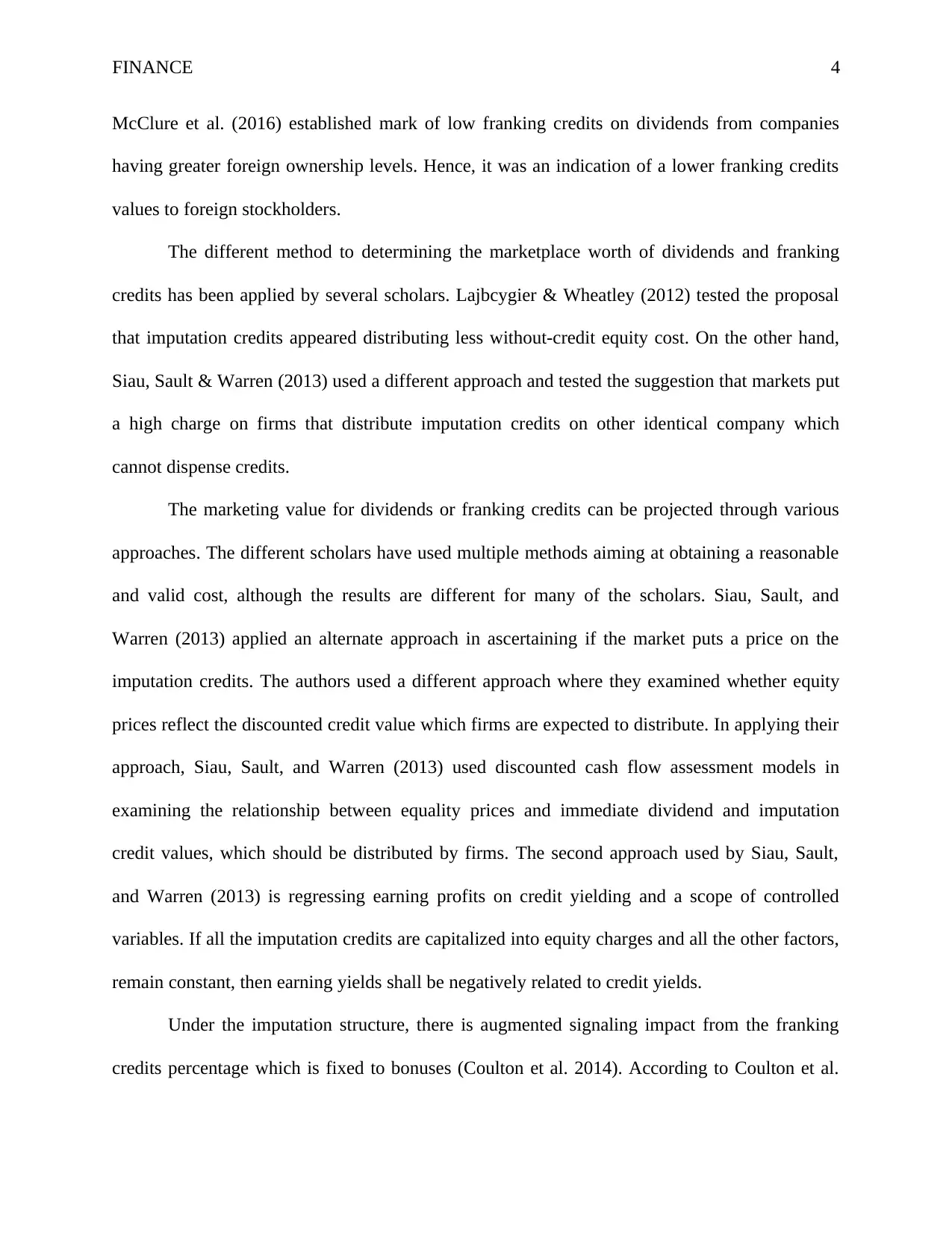
FINANCE 4
McClure et al. (2016) established mark of low franking credits on dividends from companies
having greater foreign ownership levels. Hence, it was an indication of a lower franking credits
values to foreign stockholders.
The different method to determining the marketplace worth of dividends and franking
credits has been applied by several scholars. Lajbcygier & Wheatley (2012) tested the proposal
that imputation credits appeared distributing less without-credit equity cost. On the other hand,
Siau, Sault & Warren (2013) used a different approach and tested the suggestion that markets put
a high charge on firms that distribute imputation credits on other identical company which
cannot dispense credits.
The marketing value for dividends or franking credits can be projected through various
approaches. The different scholars have used multiple methods aiming at obtaining a reasonable
and valid cost, although the results are different for many of the scholars. Siau, Sault, and
Warren (2013) applied an alternate approach in ascertaining if the market puts a price on the
imputation credits. The authors used a different approach where they examined whether equity
prices reflect the discounted credit value which firms are expected to distribute. In applying their
approach, Siau, Sault, and Warren (2013) used discounted cash flow assessment models in
examining the relationship between equality prices and immediate dividend and imputation
credit values, which should be distributed by firms. The second approach used by Siau, Sault,
and Warren (2013) is regressing earning profits on credit yielding and a scope of controlled
variables. If all the imputation credits are capitalized into equity charges and all the other factors,
remain constant, then earning yields shall be negatively related to credit yields.
Under the imputation structure, there is augmented signaling impact from the franking
credits percentage which is fixed to bonuses (Coulton et al. 2014). According to Coulton et al.
McClure et al. (2016) established mark of low franking credits on dividends from companies
having greater foreign ownership levels. Hence, it was an indication of a lower franking credits
values to foreign stockholders.
The different method to determining the marketplace worth of dividends and franking
credits has been applied by several scholars. Lajbcygier & Wheatley (2012) tested the proposal
that imputation credits appeared distributing less without-credit equity cost. On the other hand,
Siau, Sault & Warren (2013) used a different approach and tested the suggestion that markets put
a high charge on firms that distribute imputation credits on other identical company which
cannot dispense credits.
The marketing value for dividends or franking credits can be projected through various
approaches. The different scholars have used multiple methods aiming at obtaining a reasonable
and valid cost, although the results are different for many of the scholars. Siau, Sault, and
Warren (2013) applied an alternate approach in ascertaining if the market puts a price on the
imputation credits. The authors used a different approach where they examined whether equity
prices reflect the discounted credit value which firms are expected to distribute. In applying their
approach, Siau, Sault, and Warren (2013) used discounted cash flow assessment models in
examining the relationship between equality prices and immediate dividend and imputation
credit values, which should be distributed by firms. The second approach used by Siau, Sault,
and Warren (2013) is regressing earning profits on credit yielding and a scope of controlled
variables. If all the imputation credits are capitalized into equity charges and all the other factors,
remain constant, then earning yields shall be negatively related to credit yields.
Under the imputation structure, there is augmented signaling impact from the franking
credits percentage which is fixed to bonuses (Coulton et al. 2014). According to Coulton et al.
Paraphrase This Document
Need a fresh take? Get an instant paraphrase of this document with our AI Paraphraser
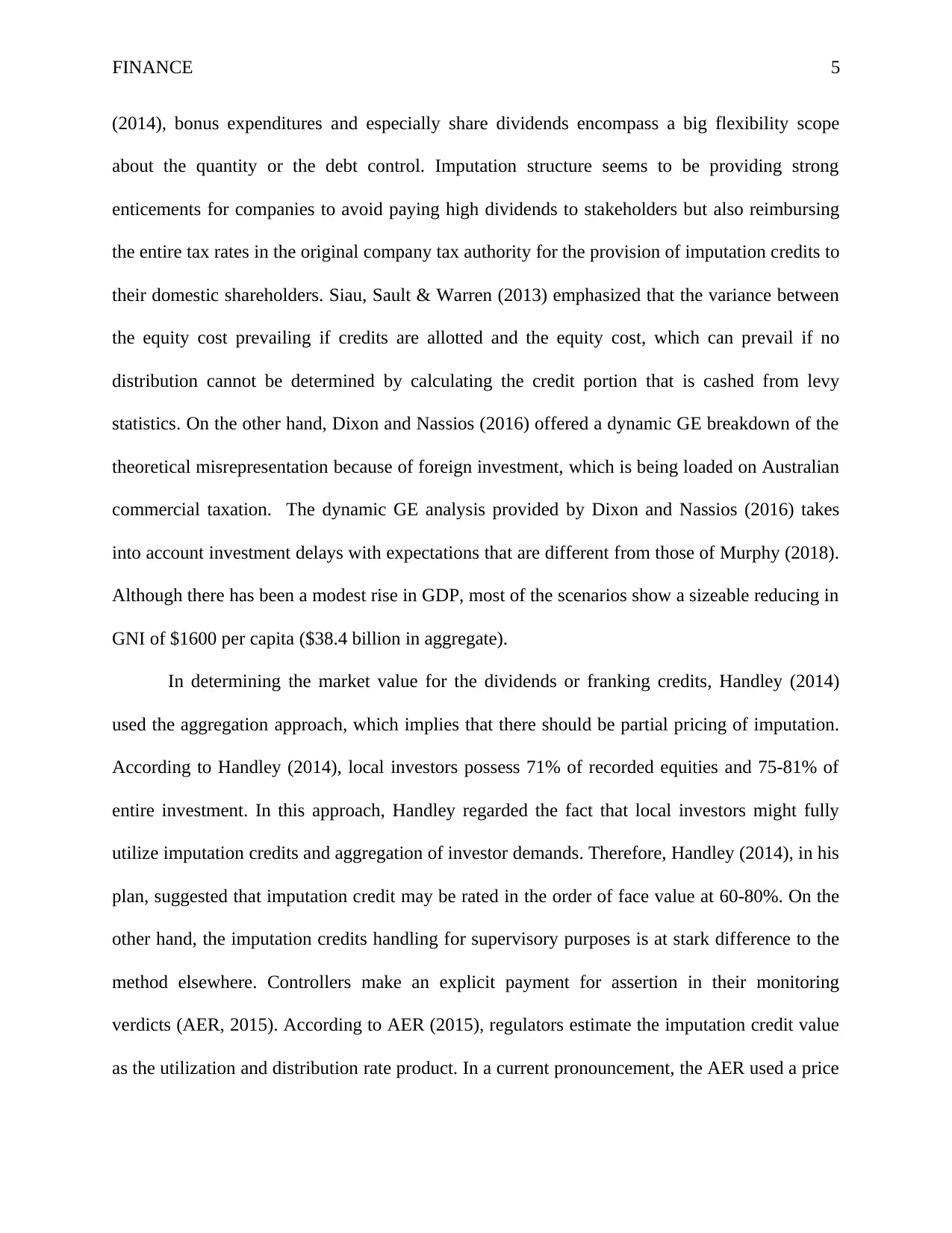
FINANCE 5
(2014), bonus expenditures and especially share dividends encompass a big flexibility scope
about the quantity or the debt control. Imputation structure seems to be providing strong
enticements for companies to avoid paying high dividends to stakeholders but also reimbursing
the entire tax rates in the original company tax authority for the provision of imputation credits to
their domestic shareholders. Siau, Sault & Warren (2013) emphasized that the variance between
the equity cost prevailing if credits are allotted and the equity cost, which can prevail if no
distribution cannot be determined by calculating the credit portion that is cashed from levy
statistics. On the other hand, Dixon and Nassios (2016) offered a dynamic GE breakdown of the
theoretical misrepresentation because of foreign investment, which is being loaded on Australian
commercial taxation. The dynamic GE analysis provided by Dixon and Nassios (2016) takes
into account investment delays with expectations that are different from those of Murphy (2018).
Although there has been a modest rise in GDP, most of the scenarios show a sizeable reducing in
GNI of $1600 per capita ($38.4 billion in aggregate).
In determining the market value for the dividends or franking credits, Handley (2014)
used the aggregation approach, which implies that there should be partial pricing of imputation.
According to Handley (2014), local investors possess 71% of recorded equities and 75-81% of
entire investment. In this approach, Handley regarded the fact that local investors might fully
utilize imputation credits and aggregation of investor demands. Therefore, Handley (2014), in his
plan, suggested that imputation credit may be rated in the order of face value at 60-80%. On the
other hand, the imputation credits handling for supervisory purposes is at stark difference to the
method elsewhere. Controllers make an explicit payment for assertion in their monitoring
verdicts (AER, 2015). According to AER (2015), regulators estimate the imputation credit value
as the utilization and distribution rate product. In a current pronouncement, the AER used a price
(2014), bonus expenditures and especially share dividends encompass a big flexibility scope
about the quantity or the debt control. Imputation structure seems to be providing strong
enticements for companies to avoid paying high dividends to stakeholders but also reimbursing
the entire tax rates in the original company tax authority for the provision of imputation credits to
their domestic shareholders. Siau, Sault & Warren (2013) emphasized that the variance between
the equity cost prevailing if credits are allotted and the equity cost, which can prevail if no
distribution cannot be determined by calculating the credit portion that is cashed from levy
statistics. On the other hand, Dixon and Nassios (2016) offered a dynamic GE breakdown of the
theoretical misrepresentation because of foreign investment, which is being loaded on Australian
commercial taxation. The dynamic GE analysis provided by Dixon and Nassios (2016) takes
into account investment delays with expectations that are different from those of Murphy (2018).
Although there has been a modest rise in GDP, most of the scenarios show a sizeable reducing in
GNI of $1600 per capita ($38.4 billion in aggregate).
In determining the market value for the dividends or franking credits, Handley (2014)
used the aggregation approach, which implies that there should be partial pricing of imputation.
According to Handley (2014), local investors possess 71% of recorded equities and 75-81% of
entire investment. In this approach, Handley regarded the fact that local investors might fully
utilize imputation credits and aggregation of investor demands. Therefore, Handley (2014), in his
plan, suggested that imputation credit may be rated in the order of face value at 60-80%. On the
other hand, the imputation credits handling for supervisory purposes is at stark difference to the
method elsewhere. Controllers make an explicit payment for assertion in their monitoring
verdicts (AER, 2015). According to AER (2015), regulators estimate the imputation credit value
as the utilization and distribution rate product. In a current pronouncement, the AER used a price
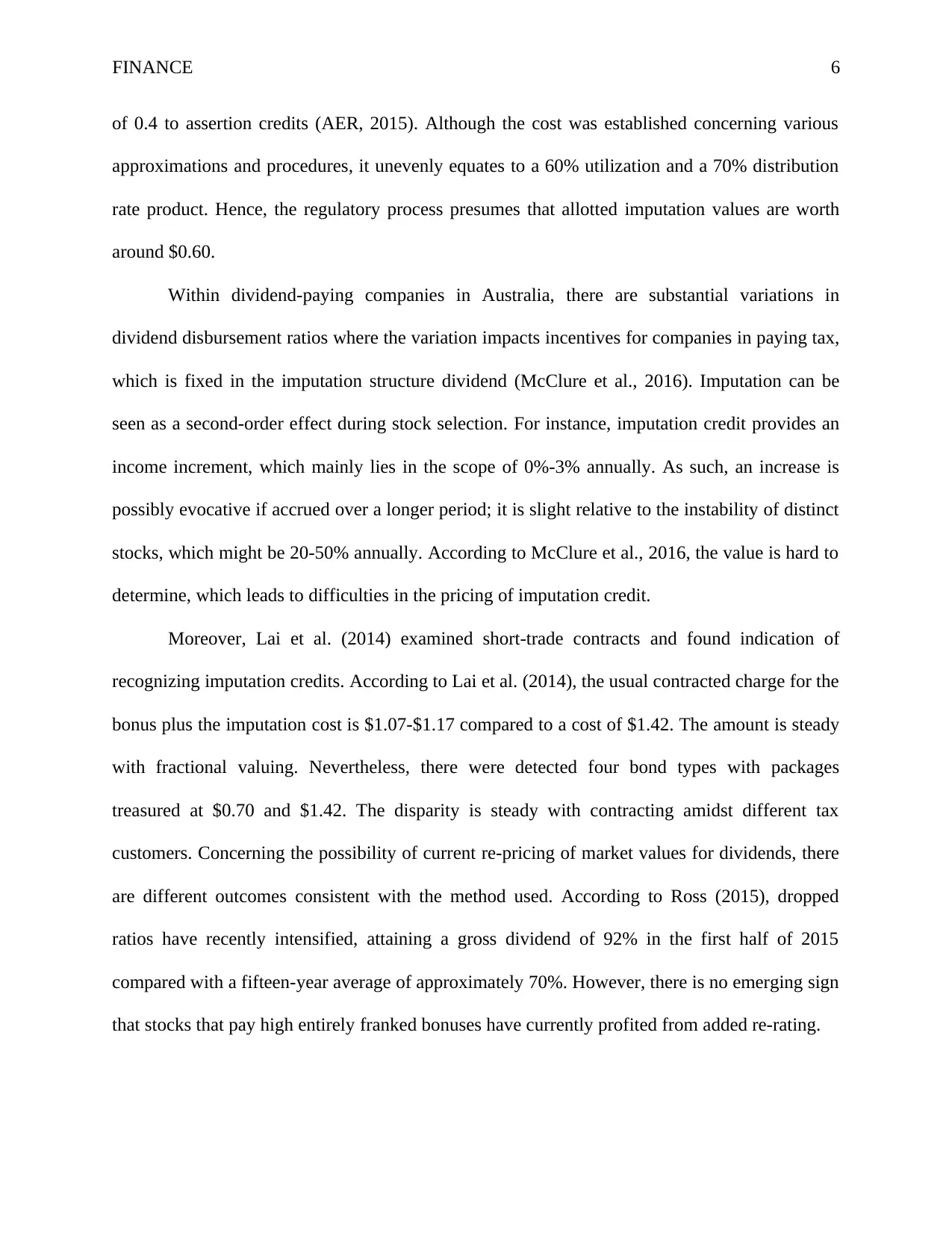
FINANCE 6
of 0.4 to assertion credits (AER, 2015). Although the cost was established concerning various
approximations and procedures, it unevenly equates to a 60% utilization and a 70% distribution
rate product. Hence, the regulatory process presumes that allotted imputation values are worth
around $0.60.
Within dividend-paying companies in Australia, there are substantial variations in
dividend disbursement ratios where the variation impacts incentives for companies in paying tax,
which is fixed in the imputation structure dividend (McClure et al., 2016). Imputation can be
seen as a second-order effect during stock selection. For instance, imputation credit provides an
income increment, which mainly lies in the scope of 0%-3% annually. As such, an increase is
possibly evocative if accrued over a longer period; it is slight relative to the instability of distinct
stocks, which might be 20-50% annually. According to McClure et al., 2016, the value is hard to
determine, which leads to difficulties in the pricing of imputation credit.
Moreover, Lai et al. (2014) examined short-trade contracts and found indication of
recognizing imputation credits. According to Lai et al. (2014), the usual contracted charge for the
bonus plus the imputation cost is $1.07-$1.17 compared to a cost of $1.42. The amount is steady
with fractional valuing. Nevertheless, there were detected four bond types with packages
treasured at $0.70 and $1.42. The disparity is steady with contracting amidst different tax
customers. Concerning the possibility of current re-pricing of market values for dividends, there
are different outcomes consistent with the method used. According to Ross (2015), dropped
ratios have recently intensified, attaining a gross dividend of 92% in the first half of 2015
compared with a fifteen-year average of approximately 70%. However, there is no emerging sign
that stocks that pay high entirely franked bonuses have currently profited from added re-rating.
of 0.4 to assertion credits (AER, 2015). Although the cost was established concerning various
approximations and procedures, it unevenly equates to a 60% utilization and a 70% distribution
rate product. Hence, the regulatory process presumes that allotted imputation values are worth
around $0.60.
Within dividend-paying companies in Australia, there are substantial variations in
dividend disbursement ratios where the variation impacts incentives for companies in paying tax,
which is fixed in the imputation structure dividend (McClure et al., 2016). Imputation can be
seen as a second-order effect during stock selection. For instance, imputation credit provides an
income increment, which mainly lies in the scope of 0%-3% annually. As such, an increase is
possibly evocative if accrued over a longer period; it is slight relative to the instability of distinct
stocks, which might be 20-50% annually. According to McClure et al., 2016, the value is hard to
determine, which leads to difficulties in the pricing of imputation credit.
Moreover, Lai et al. (2014) examined short-trade contracts and found indication of
recognizing imputation credits. According to Lai et al. (2014), the usual contracted charge for the
bonus plus the imputation cost is $1.07-$1.17 compared to a cost of $1.42. The amount is steady
with fractional valuing. Nevertheless, there were detected four bond types with packages
treasured at $0.70 and $1.42. The disparity is steady with contracting amidst different tax
customers. Concerning the possibility of current re-pricing of market values for dividends, there
are different outcomes consistent with the method used. According to Ross (2015), dropped
ratios have recently intensified, attaining a gross dividend of 92% in the first half of 2015
compared with a fifteen-year average of approximately 70%. However, there is no emerging sign
that stocks that pay high entirely franked bonuses have currently profited from added re-rating.
⊘ This is a preview!⊘
Do you want full access?
Subscribe today to unlock all pages.

Trusted by 1+ million students worldwide
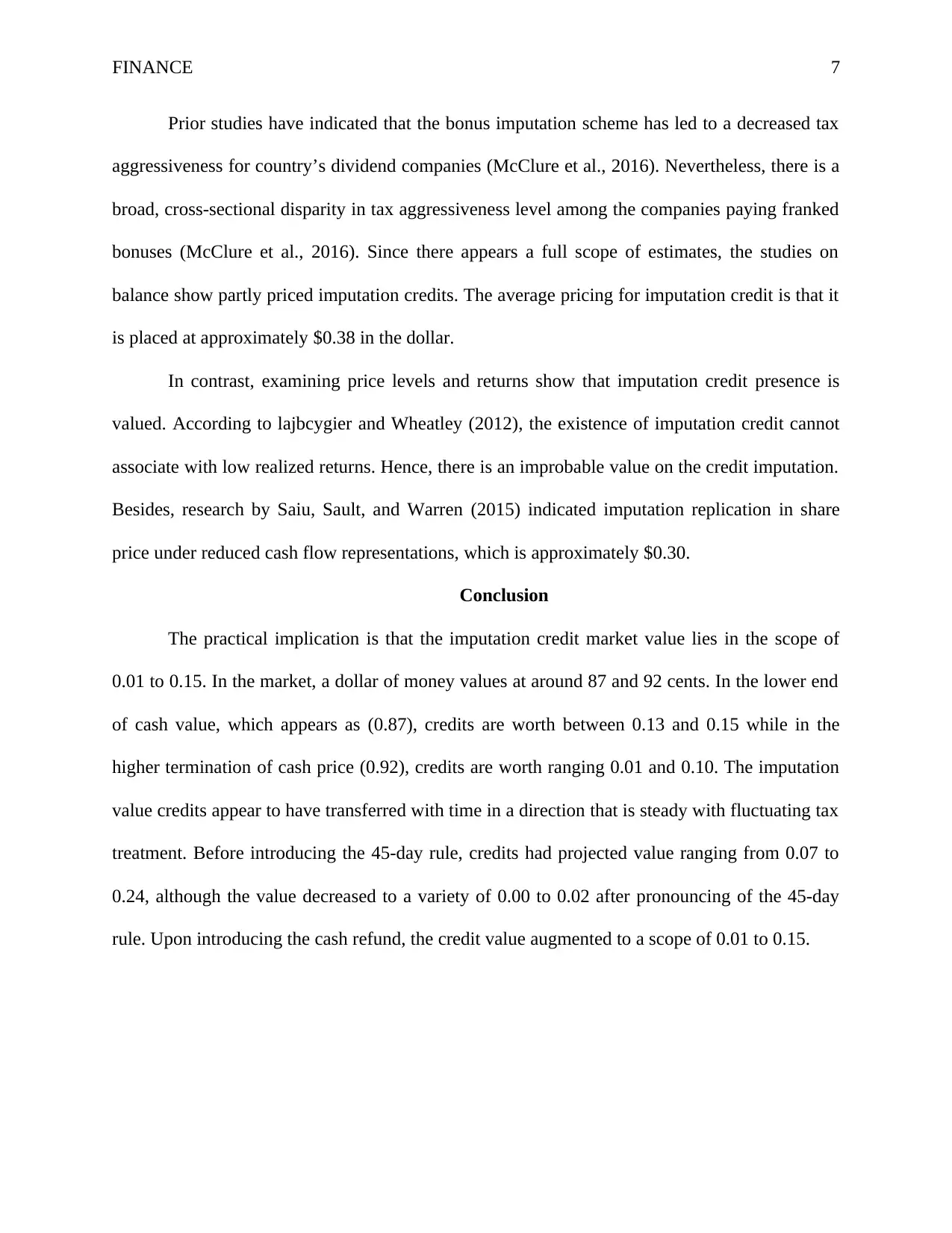
FINANCE 7
Prior studies have indicated that the bonus imputation scheme has led to a decreased tax
aggressiveness for country’s dividend companies (McClure et al., 2016). Nevertheless, there is a
broad, cross-sectional disparity in tax aggressiveness level among the companies paying franked
bonuses (McClure et al., 2016). Since there appears a full scope of estimates, the studies on
balance show partly priced imputation credits. The average pricing for imputation credit is that it
is placed at approximately $0.38 in the dollar.
In contrast, examining price levels and returns show that imputation credit presence is
valued. According to lajbcygier and Wheatley (2012), the existence of imputation credit cannot
associate with low realized returns. Hence, there is an improbable value on the credit imputation.
Besides, research by Saiu, Sault, and Warren (2015) indicated imputation replication in share
price under reduced cash flow representations, which is approximately $0.30.
Conclusion
The practical implication is that the imputation credit market value lies in the scope of
0.01 to 0.15. In the market, a dollar of money values at around 87 and 92 cents. In the lower end
of cash value, which appears as (0.87), credits are worth between 0.13 and 0.15 while in the
higher termination of cash price (0.92), credits are worth ranging 0.01 and 0.10. The imputation
value credits appear to have transferred with time in a direction that is steady with fluctuating tax
treatment. Before introducing the 45-day rule, credits had projected value ranging from 0.07 to
0.24, although the value decreased to a variety of 0.00 to 0.02 after pronouncing of the 45-day
rule. Upon introducing the cash refund, the credit value augmented to a scope of 0.01 to 0.15.
Prior studies have indicated that the bonus imputation scheme has led to a decreased tax
aggressiveness for country’s dividend companies (McClure et al., 2016). Nevertheless, there is a
broad, cross-sectional disparity in tax aggressiveness level among the companies paying franked
bonuses (McClure et al., 2016). Since there appears a full scope of estimates, the studies on
balance show partly priced imputation credits. The average pricing for imputation credit is that it
is placed at approximately $0.38 in the dollar.
In contrast, examining price levels and returns show that imputation credit presence is
valued. According to lajbcygier and Wheatley (2012), the existence of imputation credit cannot
associate with low realized returns. Hence, there is an improbable value on the credit imputation.
Besides, research by Saiu, Sault, and Warren (2015) indicated imputation replication in share
price under reduced cash flow representations, which is approximately $0.30.
Conclusion
The practical implication is that the imputation credit market value lies in the scope of
0.01 to 0.15. In the market, a dollar of money values at around 87 and 92 cents. In the lower end
of cash value, which appears as (0.87), credits are worth between 0.13 and 0.15 while in the
higher termination of cash price (0.92), credits are worth ranging 0.01 and 0.10. The imputation
value credits appear to have transferred with time in a direction that is steady with fluctuating tax
treatment. Before introducing the 45-day rule, credits had projected value ranging from 0.07 to
0.24, although the value decreased to a variety of 0.00 to 0.02 after pronouncing of the 45-day
rule. Upon introducing the cash refund, the credit value augmented to a scope of 0.01 to 0.15.
Paraphrase This Document
Need a fresh take? Get an instant paraphrase of this document with our AI Paraphraser
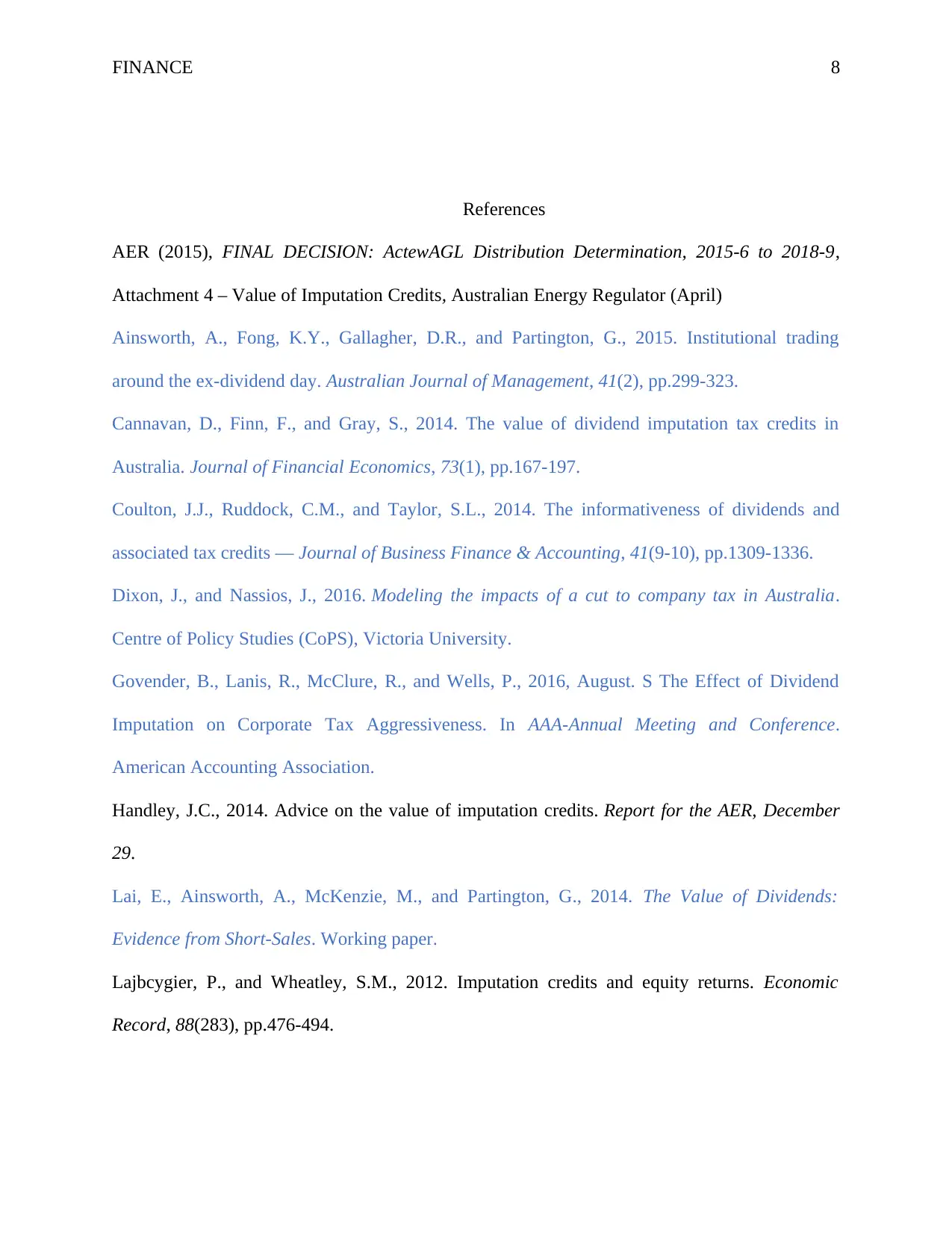
FINANCE 8
References
AER (2015), FINAL DECISION: ActewAGL Distribution Determination, 2015-6 to 2018-9,
Attachment 4 – Value of Imputation Credits, Australian Energy Regulator (April)
Ainsworth, A., Fong, K.Y., Gallagher, D.R., and Partington, G., 2015. Institutional trading
around the ex-dividend day. Australian Journal of Management, 41(2), pp.299-323.
Cannavan, D., Finn, F., and Gray, S., 2014. The value of dividend imputation tax credits in
Australia. Journal of Financial Economics, 73(1), pp.167-197.
Coulton, J.J., Ruddock, C.M., and Taylor, S.L., 2014. The informativeness of dividends and
associated tax credits — Journal of Business Finance & Accounting, 41(9-10), pp.1309-1336.
Dixon, J., and Nassios, J., 2016. Modeling the impacts of a cut to company tax in Australia.
Centre of Policy Studies (CoPS), Victoria University.
Govender, B., Lanis, R., McClure, R., and Wells, P., 2016, August. S The Effect of Dividend
Imputation on Corporate Tax Aggressiveness. In AAA-Annual Meeting and Conference.
American Accounting Association.
Handley, J.C., 2014. Advice on the value of imputation credits. Report for the AER, December
29.
Lai, E., Ainsworth, A., McKenzie, M., and Partington, G., 2014. The Value of Dividends:
Evidence from Short-Sales. Working paper.
Lajbcygier, P., and Wheatley, S.M., 2012. Imputation credits and equity returns. Economic
Record, 88(283), pp.476-494.
References
AER (2015), FINAL DECISION: ActewAGL Distribution Determination, 2015-6 to 2018-9,
Attachment 4 – Value of Imputation Credits, Australian Energy Regulator (April)
Ainsworth, A., Fong, K.Y., Gallagher, D.R., and Partington, G., 2015. Institutional trading
around the ex-dividend day. Australian Journal of Management, 41(2), pp.299-323.
Cannavan, D., Finn, F., and Gray, S., 2014. The value of dividend imputation tax credits in
Australia. Journal of Financial Economics, 73(1), pp.167-197.
Coulton, J.J., Ruddock, C.M., and Taylor, S.L., 2014. The informativeness of dividends and
associated tax credits — Journal of Business Finance & Accounting, 41(9-10), pp.1309-1336.
Dixon, J., and Nassios, J., 2016. Modeling the impacts of a cut to company tax in Australia.
Centre of Policy Studies (CoPS), Victoria University.
Govender, B., Lanis, R., McClure, R., and Wells, P., 2016, August. S The Effect of Dividend
Imputation on Corporate Tax Aggressiveness. In AAA-Annual Meeting and Conference.
American Accounting Association.
Handley, J.C., 2014. Advice on the value of imputation credits. Report for the AER, December
29.
Lai, E., Ainsworth, A., McKenzie, M., and Partington, G., 2014. The Value of Dividends:
Evidence from Short-Sales. Working paper.
Lajbcygier, P., and Wheatley, S.M., 2012. Imputation credits and equity returns. Economic
Record, 88(283), pp.476-494.
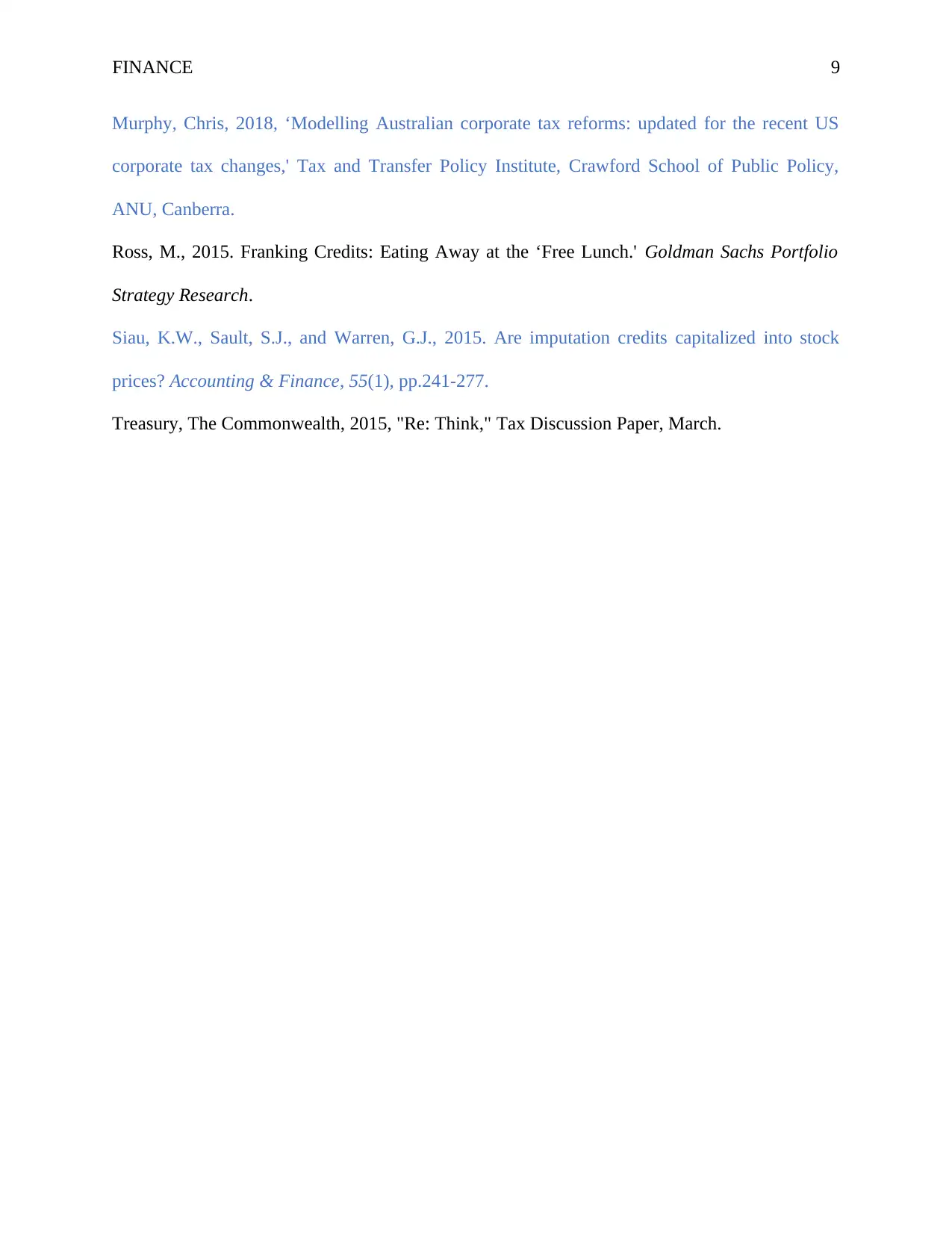
FINANCE 9
Murphy, Chris, 2018, ‘Modelling Australian corporate tax reforms: updated for the recent US
corporate tax changes,' Tax and Transfer Policy Institute, Crawford School of Public Policy,
ANU, Canberra.
Ross, M., 2015. Franking Credits: Eating Away at the ‘Free Lunch.' Goldman Sachs Portfolio
Strategy Research.
Siau, K.W., Sault, S.J., and Warren, G.J., 2015. Are imputation credits capitalized into stock
prices? Accounting & Finance, 55(1), pp.241-277.
Treasury, The Commonwealth, 2015, "Re: Think," Tax Discussion Paper, March.
Murphy, Chris, 2018, ‘Modelling Australian corporate tax reforms: updated for the recent US
corporate tax changes,' Tax and Transfer Policy Institute, Crawford School of Public Policy,
ANU, Canberra.
Ross, M., 2015. Franking Credits: Eating Away at the ‘Free Lunch.' Goldman Sachs Portfolio
Strategy Research.
Siau, K.W., Sault, S.J., and Warren, G.J., 2015. Are imputation credits capitalized into stock
prices? Accounting & Finance, 55(1), pp.241-277.
Treasury, The Commonwealth, 2015, "Re: Think," Tax Discussion Paper, March.
⊘ This is a preview!⊘
Do you want full access?
Subscribe today to unlock all pages.

Trusted by 1+ million students worldwide
1 out of 9
Related Documents
Your All-in-One AI-Powered Toolkit for Academic Success.
+13062052269
info@desklib.com
Available 24*7 on WhatsApp / Email
![[object Object]](/_next/static/media/star-bottom.7253800d.svg)
Unlock your academic potential
Copyright © 2020–2025 A2Z Services. All Rights Reserved. Developed and managed by ZUCOL.





